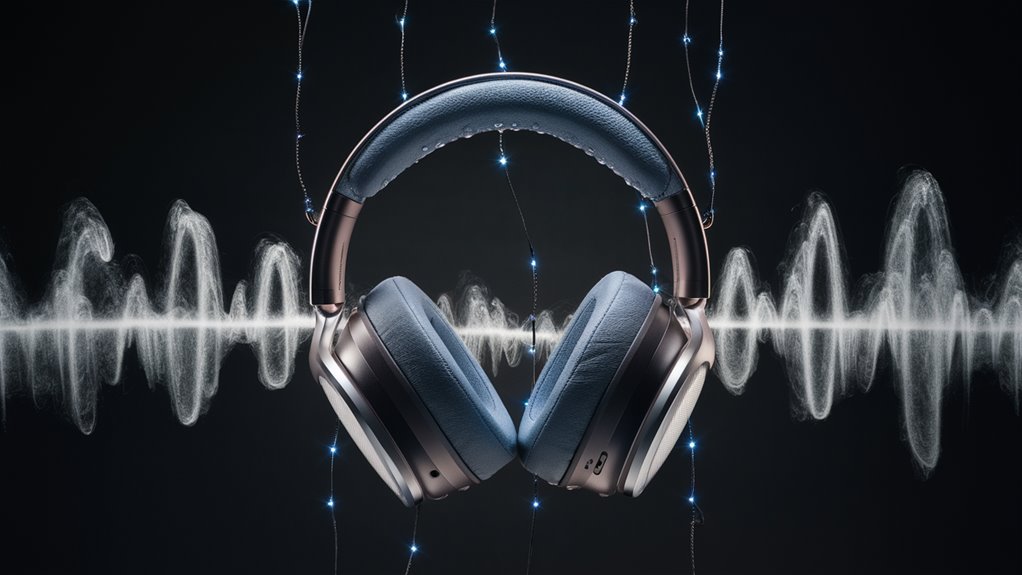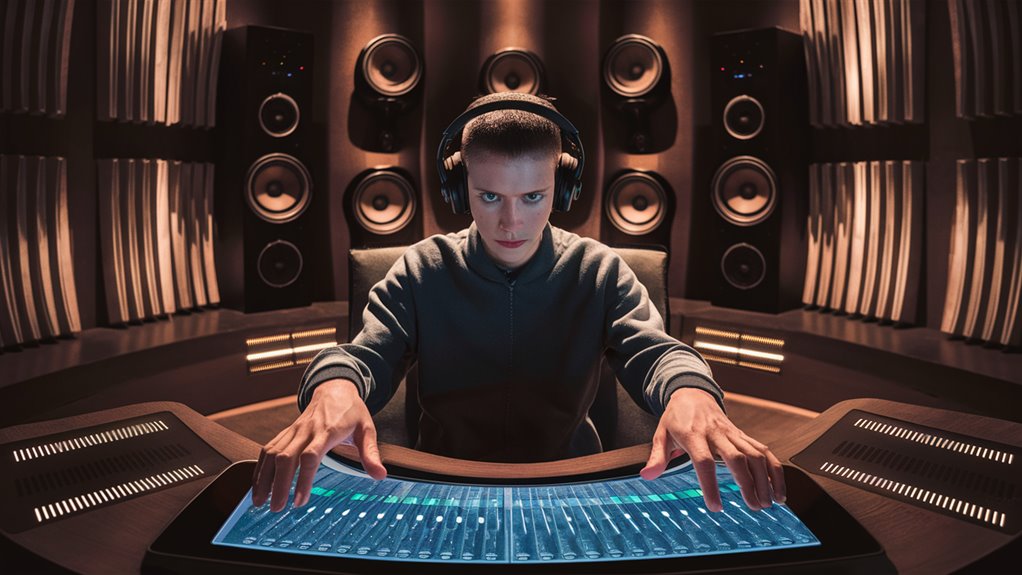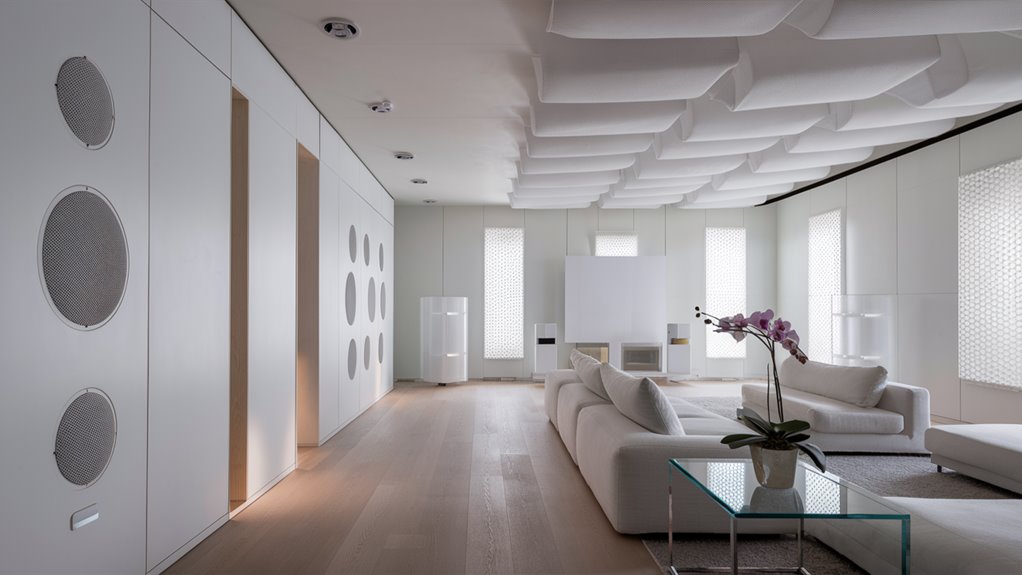
Audio Tech: How New Changes Make Us Hear Better

Today’s audio changes are big and change how we hear sounds in all ways. The latest audio tech uses 3D sound making and AI help to make real-life sound worlds that change our sound feel.
Better Sound Files
New sound files now give clearer sounds with up to 24-bit/192kHz, better than old CD sounds. New wireless sound codes like aptX HD and LDAC mean clean wireless play, fixing old Bluetooth sound issues.
Smart Sound Work
Smart sound setups check and fix sound non-stop, using smart steps to set sound right for any spot or thing we do. These smart sound changes think about room sound, other noise, and what we like to hear to give the best sound in any place.
Sound Just For You
New moves in sound setup and room sound link are changing how we get to sound. Smart speakers make sound zones just for us, while AI sound help fixes sound for each person’s hearing needs and likes. These sound changes are just starting a new time in how we hear and feel sounds.
All About 3D Sound
What is 3D Sound
3D sound tech has started a big shift in making sound digital, making you feel like you are really there. This 3D sound way makes lifelike sound scenes by putting sound bits in a fake space around you. With smart head track and the right headphones, 3D sound keeps sound spots still no matter how you move your head, making it feel very real.
How it Works
At the heart of 3D sound work is smart digital signal work using head-related sound forms (HRTFs). These smart math forms copy how our ears hear sound based on where it comes from and how we are made. Today’s 3D sound systems can handle lots of different sound bits, putting each one just right in a full 360-degree space 베트남 밤문화
Where it’s Used
3D sound use is doing more than changing music, it’s moving many digital types:
- Game worlds: Making games feel real
- VR worlds: Making them feel more there
- Video chats: Making voices clear
- Shows: Giving movie-like sound
How Codes Work
New 3D sound codes are good at giving deep sound experiences while keeping file needs low. Big names like Apple’s 3D Sound, Sony’s 360 Sound, and Dolby Atmos set new bars in digital sound, big changing how we mix with sound online.
AI and Sound Work
AI Helps Sound Work
AI has deeply changed how sound is worked on in digital places. AI steps look at sound signals all the time, making fast changes to make sound clear, cut noise, and set sound waves right. From lots of sound info, these setups find and fix small wrong bits that old digital sound work (DSP) can’t see.
Smart Noise Cut
AI noise cut is really good at knowing sound we want from sound we don’t. Today’s setups use smart looking to split:
- Talking from background sound
- Music from other sounds
- Different sounds in music
- group event with our comprehensive
Smart Networks and Sound Help
New Sound Help
Learning machines are great at fixing sound and making it better, doing things like:
- Making poor sound better
- Bringing back lost sound waves
- Fixing broken sound bits
Changing Work
Smart networks keep looking and changing to make sound right in all types of hearing spots. This changing system keeps sound great whether in:
- Loud city spots
- Quiet inside spots
- Tricky sound spots
The tech guesses right to build sound info while keeping sound feel real in the help process.
Your Sound, Your Way

Your Sound Setups
Today’s sound systems give unmatched personal changes through smart steps and deep looking at what you like. These systems watch how we hear, where we are, and how we play with sound to make detailed sound setups just for you.
How Personal Sound Works
Deep sound changes look at key things like how we hear, sound waves we like, and where we hear. The system makes live changes in many ways:
- Changing sound places
- Setting sound waves
- Fixing room sound
Learning and Changing Sound
Smart sound spots use learning steps to keep making your sound better. The system tracks key info:
- How we change sound level
- What we pick to hear
- How often we play it
- How often we skip it
All Sound Forms Better
Personal changes work over all sound forms:
- Making music streams better
- Making podcasts clear
- Setting books to hear
- Tailoring game sound
Sound for What You Do
The tech changes with what you do:
- Sound for working out
- Sound for work
- Relaxing sounds
- Commuting sound fixes
These smart setups move smoothly between sound setups, making sure you hear well in all you do and everywhere.
Smart Sound Spots
New Sound Tech for You
Smart sound spots are a big step in 3D sound tech, using smart sensors, mics, and speakers to change sound traits in real spots. These top-line systems check space traits, how many people are there, and other noise to make sound just right.
Changing Sound Answers
Today’s smart sound answers use strong changing steps to make just-right sound areas in one big space. Sound hiding setups in open work spots up work focus by lowering how much we hear talk while keeping sound clear where we team up. Smart sound aim tech and sound arrays make sure sound goes just where needed.
AI in Sound Work
AI leads the new wave of sound control systems, using smart learning steps that react to what we like and how spots change. These smart systems auto-fix echo times, sound waves, and sound force right for different doings. From changing meeting rooms that move easy from show to talk mode to smart show spots that set sound right for different music types, smart sound spots are changing how sound and space mix.
About Top Sound Forms
Sound Change
Better sound forms have changed how we make digital sound, giving top sound bits and more sound range. DSD (Direct Stream Digital) and PCM (Pulse Code Modulation) at 24-bit/192kHz catch sound with much more info than old 16-bit/44.1kHz CD quality.
Key Sound Bits and Comparisons
How fast we sample and bit deeps show the main changes between usual and hi-res sound forms. Top sound now catches waves up to 96kHz, much over the top ear range of 20kHz. Whole sound squish forms like FLAC, ALAC, and MQA keep all recorded sound while keeping files small.
Need to Play Well and Store
Best play needs top gear, like a high-end DAC (Digital-to-Analog Converter) for high needs, with top amps and sound devices. Storing high-end sound files needs 2-3GB per album, more than 350MB for usual CD quality. New digital store setups and online play spots have made these better forms more open to sound lovers and music fans.
Wireless Sounds
New Moves in Sound
With better digital sound, wireless tech has changed how we hear sound. Bluetooth sound send has moved from basic to new steps like aptX HD and LDAC, giving near-perfect wireless sound at good 24-bit/96kHz sound levels.
Three Big Sound Changes
No Wires Sound (TWS) Moves
TWS tech was a big moment in wireless sound, cutting earbud wires while adding changing noise cut and 3D sound work. This big change has changed how millions hear sounds on the go.
Top WiFi Sound Play
WiFi sound play steps like Apple AirPlay 2 and Google Cast have grown a lot, letting us do cool things like linking rooms and high-end sound share. These moves give sound lovers top-grade sound over wireless nets.
Low Wait Sound Help
Low wait sound codes have fixed timing issues in wireless games and videos, making sure sound and sight line up. This tech jump has made wireless sound work for time-tight uses.
Smart Net Steps
Now, wireless sound systems use net linking tech, letting devices talk well and cover more space through node talk. These smart net skills have kicked old limits on wireless sound, giving steady, top sound send over big spaces.


